

Compact Muon Solenoid
LHC, CERN
| CMS-PAS-B2G-16-013 | ||
| Search for heavy resonances decaying to top and vector-like quarks in the all-hadronic channel at √s= 13 TeV | ||
| CMS Collaboration | ||
| September 2016 | ||
| Abstract: Many models predicting a heavy neutral spin-1 resonance also predict the existence of vector-like quarks. Such a hypothetical resonance might then predominantly decay to these heavy quark partners rather than to standard model particles. We present a search for a new heavy spin-1 resonance (Z' boson) decaying to a top quark and a heavy vector-like top partner (T'). The analysis is tailored to the final state where the T' decays to a W boson and a b quark. We focus on all-hadronic final states, where both the associated top quark and the W boson from the T' decay in turn decay hadronically. The decay products of the top quark and the W boson are highly boosted and cannot be reconstructed as separate jets. These decays are instead reconstructed as single wide jets. Jet substructure techniques and b-tagging identification are used to identify these wide jets as top quark and vector boson candidates. | ||
|
Links:
CDS record (PDF) ;
CADI line (restricted) ;
These preliminary results are superseded in this paper, JHEP 09 (2017) 053. The superseded preliminary plots can be found here. |
||
| Figures | |
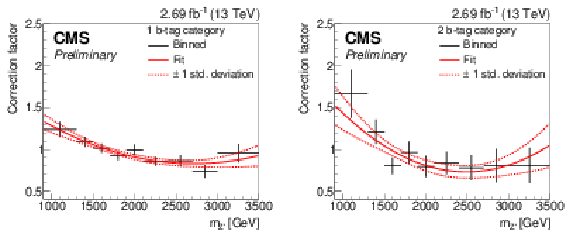
png pdf |
Figure 1:
Bin-by-bin ratio of the signal region histogram over the sideband region in simulated events. The histograms are normalized to unity before computing the ratio. The ratio is fitted with a parabola, used as a correction factor to weight the events in the sideband region in data to reproduce the shape of the QCD multijet background in the signal region. The left (right) plot shows the event region where the top-jet has zero (at least one) b-tagged subjet. |

png pdf |
Figure 1-a:
Bin-by-bin ratio of the signal region histogram over the sideband region in simulated events. The histograms are normalized to unity before computing the ratio. The ratio is fitted with a parabola, used as a correction factor to weight the events in the sideband region in data to reproduce the shape of the QCD multijet background in the signal region. The plot shows the event region where the top-jet has zero b-tagged subjet. |
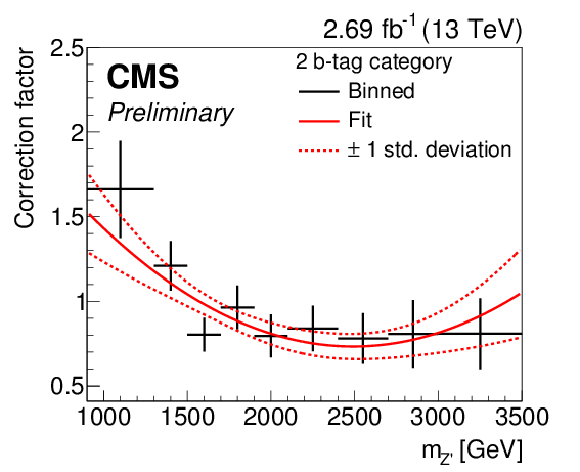
png pdf |
Figure 1-b:
Bin-by-bin ratio of the signal region histogram over the sideband region in simulated events. The histograms are normalized to unity before computing the ratio. The ratio is fitted with a parabola, used as a correction factor to weight the events in the sideband region in data to reproduce the shape of the QCD multijet background in the signal region. The plot shows the event region where the top-jet has at least one b-tagged subjet. |
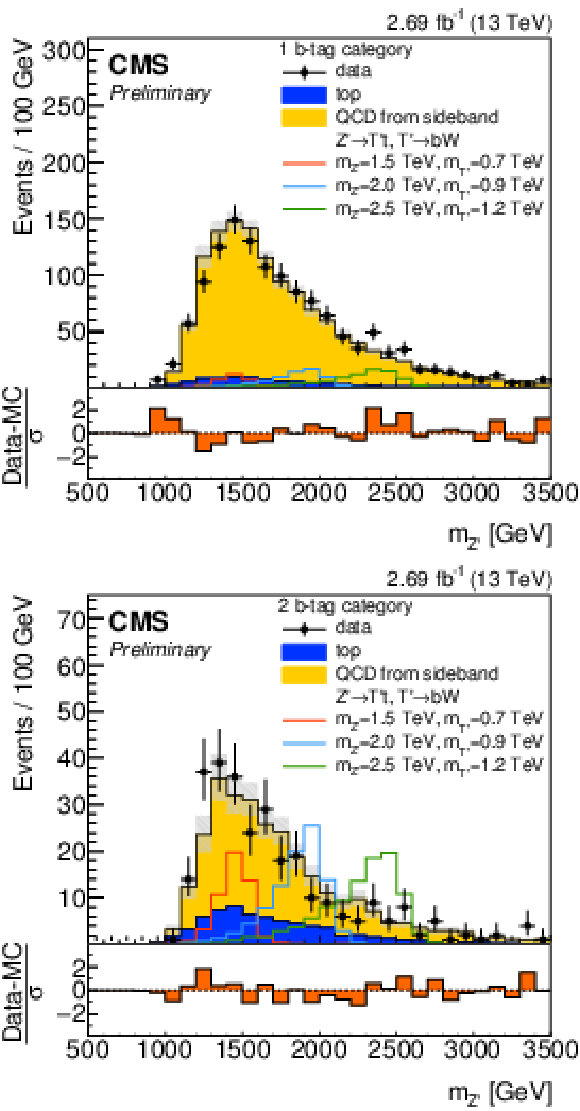
png pdf |
Figure 2:
Distribution of the invariant mass of the Z' candidate for the signal region with 1 b-tag (top row) and 2 b-tag (bottom row). The yellow distribution is the QCD multijet background estimated with the data-driven procedure, the blue distribution is the SM top background estimated from simulated events, the black dots are the data. The gray bands are the statistical and systematic uncertainties affecting the backgrounds. The colored solid lines represent the distributions for some of the signal hypotheses: red for Z'(1500 GeV) → T't, T'(700 GeV) → Wb, light blue for Z'(2000 GeV) → T't, T'(900 GeV) → Wb, and green for Z'(2500 GeV) → T't, T'(1200 GeV) → Wb. The signal distributions are each normalized to a cross section of 1 pb. |
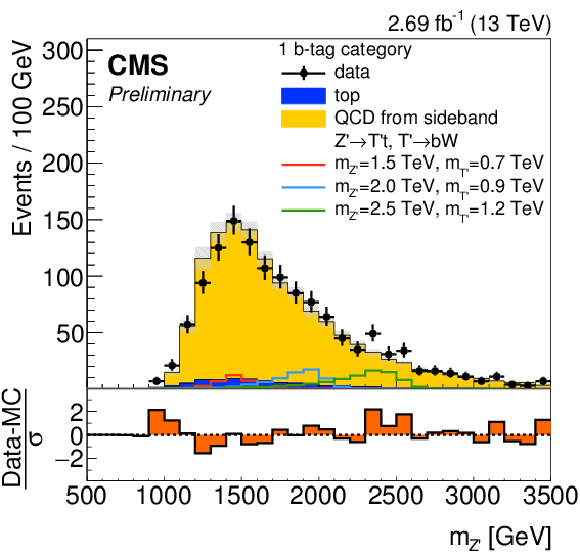
png pdf |
Figure 2-a:
Distribution of the invariant mass of the Z' candidate for the signal region with 1 b-tag. The yellow distribution is the QCD multijet background estimated with the data-driven procedure, the blue distribution is the SM top background estimated from simulated events, the black dots are the data. The gray bands are the statistical and systematic uncertainties affecting the backgrounds. The colored solid lines represent the distributions for some of the signal hypotheses: red for Z'(1500 GeV) → T't, T'(700 GeV) → Wb, light blue for Z'(2000 GeV) → T't, T'(900 GeV) → Wb, and green for Z'(2500 GeV) → T't, T'(1200 GeV) → Wb. The signal distributions are each normalized to a cross section of 1 pb. |
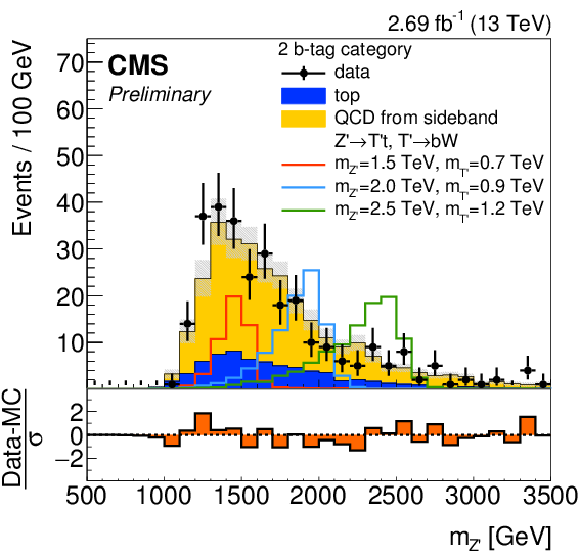
png pdf |
Figure 2-b:
Distribution of the invariant mass of the Z' candidate for the signal region with 2 b-tag. The yellow distribution is the QCD multijet background estimated with the data-driven procedure, the blue distribution is the SM top background estimated from simulated events, the black dots are the data. The gray bands are the statistical and systematic uncertainties affecting the backgrounds. The colored solid lines represent the distributions for some of the signal hypotheses: red for Z'(1500 GeV) → T't, T'(700 GeV) → Wb, light blue for Z'(2000 GeV) → T't, T'(900 GeV) → Wb, and green for Z'(2500 GeV) → T't, T'(1200 GeV) → Wb. The signal distributions are each normalized to a cross section of 1 pb. |

png pdf |
Figure 3:
T' candidate invariant mass distribution for the 1 b-tag (top left) and 2 b-tag (top right) categories, and distribution of the HT, calculated as the sum of the pT of the three jets used in the event, again for the 1 b-tag (bottom right) and 2 b-tag (bottom right) categories. The signal distributions are each normalized to a cross section of 1 pb. |
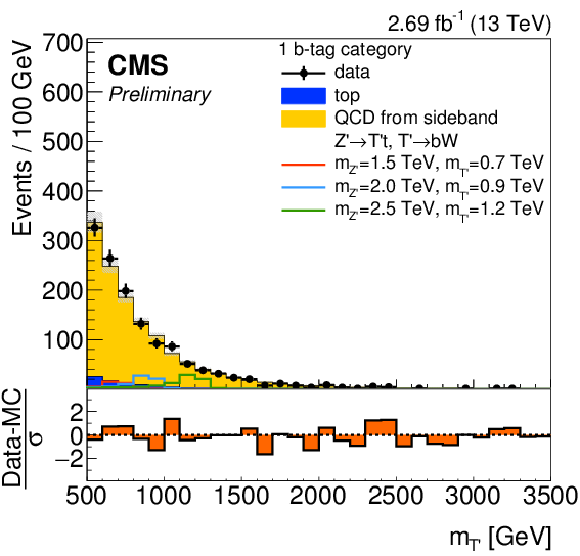
png pdf |
Figure 3-a:
T' candidate invariant mass distribution for the 1 b-tag category. The signal distributions are each normalized to a cross section of 1 pb. |
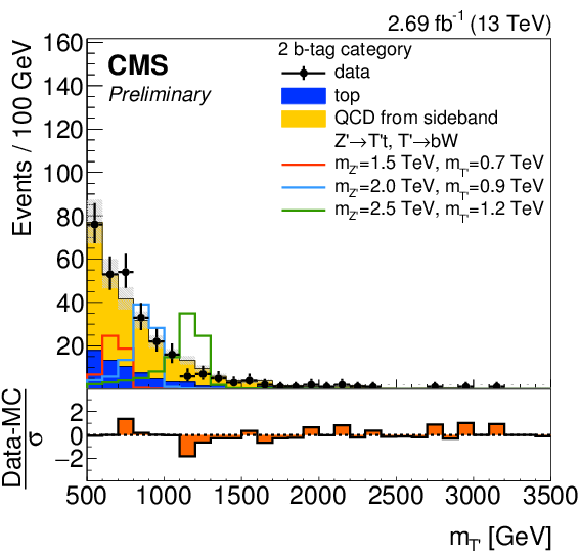
png pdf |
Figure 3-b:
T' candidate invariant mass distribution for the 2 b-tag category. The signal distributions are each normalized to a cross section of 1 pb. |
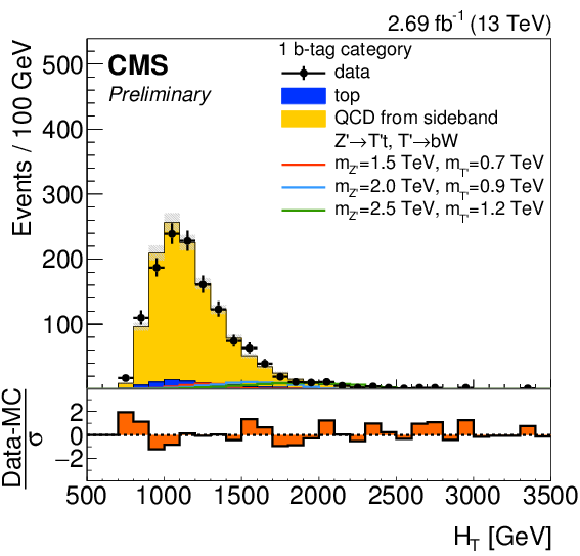
png pdf |
Figure 3-c:
Distribution of HT, calculated as the sum of the pT of the three jets used in the event, for the 1 b-tag category. The signal distributions are each normalized to a cross section of 1 pb. |

png pdf |
Figure 3-d:
Distribution of HT, calculated as the sum of the pT of the three jets used in the event, for the 2 b-tag category. The signal distributions are each normalized to a cross section of 1 pb. |
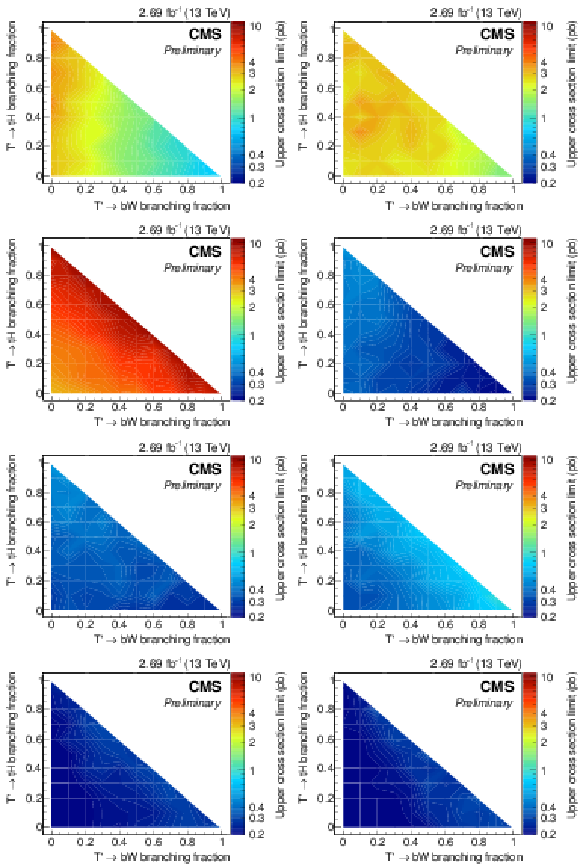
png pdf |
Figure 4:
Observed cross section limits for Z′→T′t for different hypotheses of the Z' mass, the T' mass, and the branching fraction of the T' in bW, tH, tZ. First row, from left to right: mZ′= 1.5 TeV and mT′= 0.7 TeV, mZ′= 1.5 TeV and mT′= 0.9 TeV. Second row, from left to right: mZ′= 1.5 TeV and mT′= 1.2 TeV, mZ′= 2.0 TeV and mT′= 0.9 TeV. Third row, from left to right: mZ′= 2.0 TeV and mT′= 1.2 TeV, mZ′= 2.0 TeV and mT′= 1.5 TeV. Fourth row, from left to right: mZ′= 2.5 TeV and mT′= 1.2 TeV, mZ′= 2.5 TeV and mT′= 1.5 TeV. |

png pdf |
Figure 4-a:
Observed cross section limits for Z′→T′t for the following hypothesis for the Z' mass, the T' mass, and the branching fraction of the T' in bW, tH, tZ: mZ′= 1.5 TeV and mT′= 0.7 TeV. |
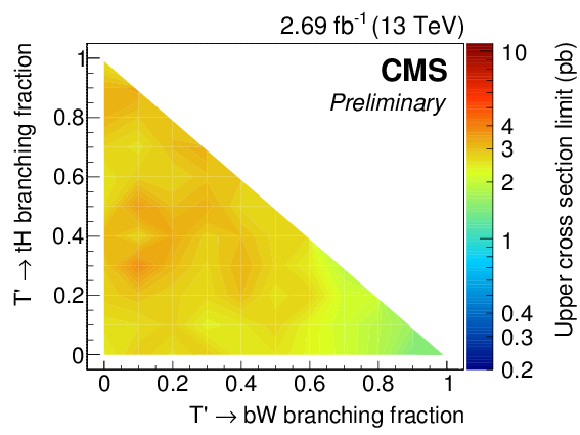
png pdf |
Figure 4-b:
Observed cross section limits for Z′→T′t for the following hypothesis for the Z' mass, the T' mass, and the branching fraction of the T' in bW, tH, tZ: mZ′= 1.5 TeV and mT′= 0.9 TeV. |
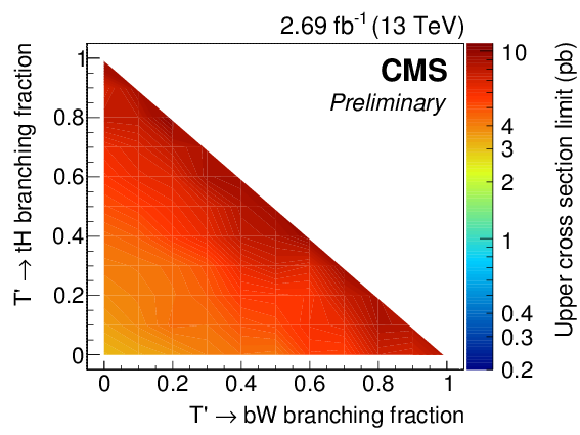
png pdf |
Figure 4-c:
Observed cross section limits for Z′→T′t for the following hypothesis for the Z' mass, the T' mass, and the branching fraction of the T' in bW, tH, tZ: mZ′= 1.5 TeV and mT′= 1.2 TeV. |

png pdf |
Figure 4-d:
Observed cross section limits for Z′→T′t for the following hypothesis for the Z' mass, the T' mass, and the branching fraction of the T' in bW, tH, tZ: mZ′= 2.0 TeV and mT′= 0.9 TeV. |
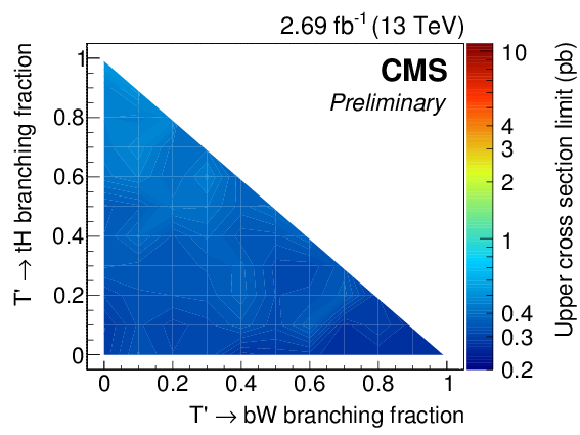
png pdf |
Figure 4-e:
Observed cross section limits for Z′→T′t for the following hypothesis for the Z' mass, the T' mass, and the branching fraction of the T' in bW, tH, tZ: mZ′= 2.0 TeV and mT′= 1.2 TeV. |
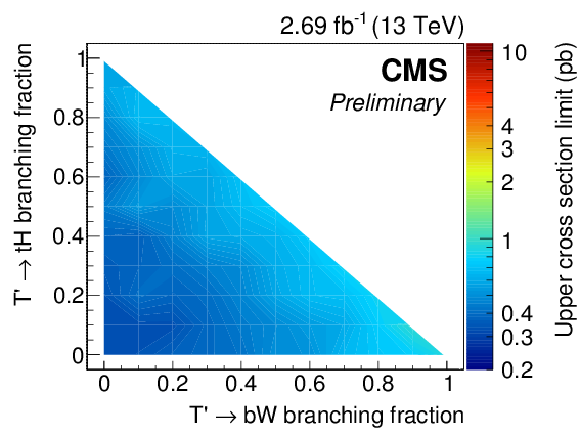
png pdf |
Figure 4-f:
Observed cross section limits for Z′→T′t for the following hypothesis for the Z' mass, the T' mass, and the branching fraction of the T' in bW, tH, tZ: mZ′= 2.0 TeV and mT′= 1.5 TeV. |
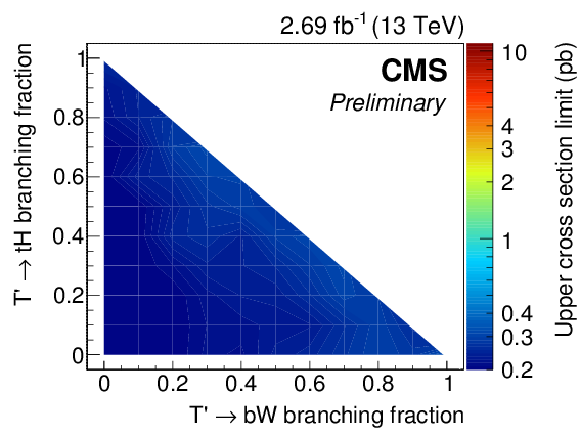
png pdf |
Figure 4-g:
Observed cross section limits for Z′→T′t for the following hypothesis for the Z' mass, the T' mass, and the branching fraction of the T' in bW, tH, tZ: mZ′= 2.5 TeV and mT′= 1.2 TeV. |

png pdf |
Figure 4-h:
Observed cross section limits for Z′→T′t for the following hypothesis for the Z' mass, the T' mass, and the branching fraction of the T' in bW, tH, tZ: mZ′= 2.5 TeV and mT′= 1.5 TeV. |
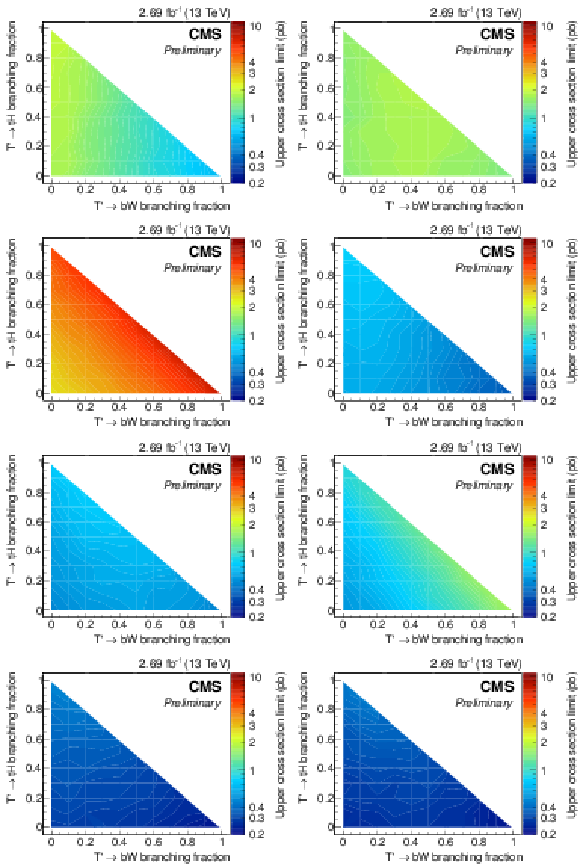
png pdf |
Figure 5:
Expected cross section limits for Z′→T′t for different hypotheses of the Z' mass, the T' mass, and the branching fraction of the T' in bW, tH, tZ. First row, from left to right: mZ′= 1.5 TeV and mT′= 0.7 TeV, mZ′= 1.5 TeV and mT′= 0.9 TeV. Second row, from left to right: mZ′= 1.5 TeV and mT′= 1.2 TeV, mZ′= 2.0 TeV and mT′= 0.9 TeV. Third row, from left to right: mZ′= 2.0 TeV and mT′= 1.2 TeV, mZ′= 2.0 TeV and mT′= 1.5 TeV. Fourth row, from left to right: mZ′= 2.5 TeV and mT′= 1.2 TeV, mZ′= 2.5 TeV and mT′= 1.5 TeV. |
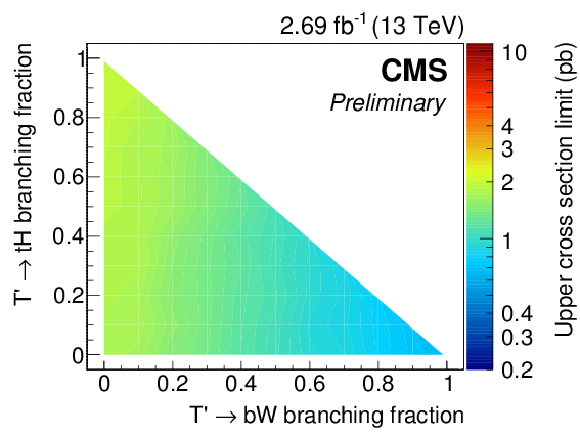
png pdf |
Figure 5-a:
Expected cross section limits for Z′→T′t for the following hypothesis of the Z' mass, the T' mass, and the branching fraction of the T' in bW, tH, tZ: mZ′= 1.5 TeV and mT′= 0.7 TeV. |
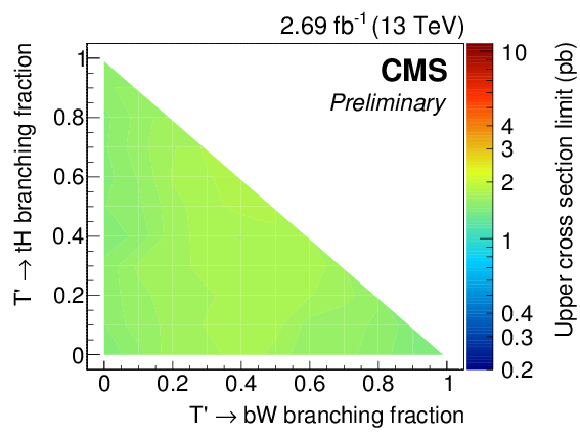
png pdf |
Figure 5-b:
Expected cross section limits for Z′→T′t for the following hypothesis of the Z' mass, the T' mass, and the branching fraction of the T' in bW, tH, tZ: mZ′= 1.5 TeV and mT′= 0.9 TeV. |
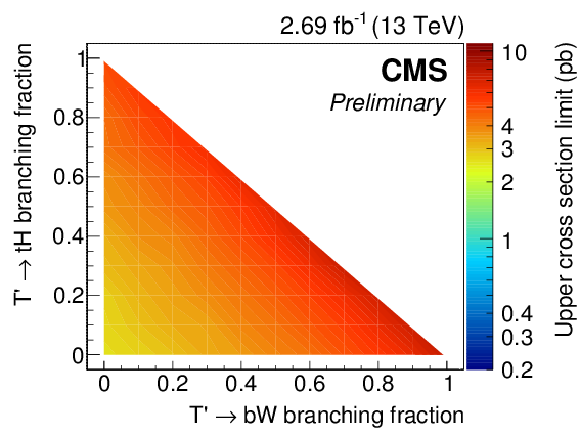
png pdf |
Figure 5-c:
Expected cross section limits for Z′→T′t for the following hypothesis of the Z' mass, the T' mass, and the branching fraction of the T' in bW, tH, tZ: mZ′= 1.5 TeV and mT′= 1.2 TeV. |

png pdf |
Figure 5-d:
Expected cross section limits for Z′→T′t for the following hypothesis of the Z' mass, the T' mass, and the branching fraction of the T' in bW, tH, tZ: mZ′= 2.0 TeV and mT′= 0.9 TeV. |

png pdf |
Figure 5-e:
Expected cross section limits for Z′→T′t for the following hypothesis of the Z' mass, the T' mass, and the branching fraction of the T' in bW, tH, tZ: mZ′= 2.0 TeV and mT′= 1.2 TeV. |

png pdf |
Figure 5-f:
Expected cross section limits for Z′→T′t for the following hypothesis of the Z' mass, the T' mass, and the branching fraction of the T' in bW, tH, tZ: mZ′= 2.0 TeV and mT′= 1.5 TeV. |
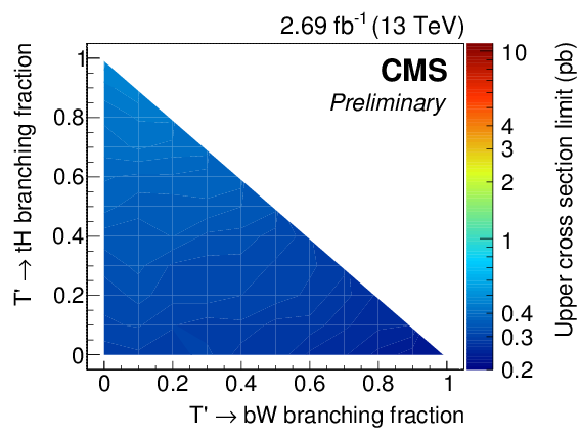
png pdf |
Figure 5-g:
Expected cross section limits for Z′→T′t for the following hypothesis of the Z' mass, the T' mass, and the branching fraction of the T' in bW, tH, tZ: mZ′= 2.5 TeV and mT′= 1.2 TeV. |
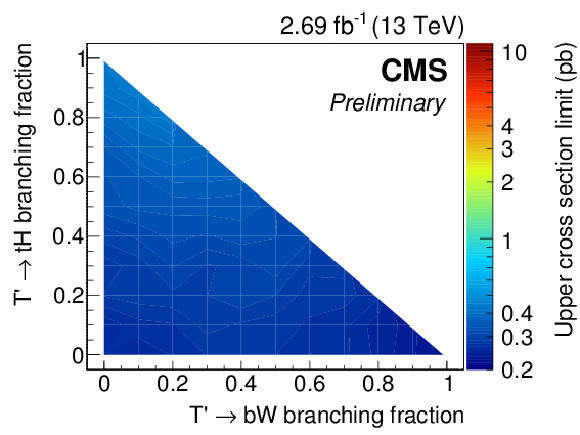
png pdf |
Figure 5-h:
Expected cross section limits for Z′→T′t for the following hypothesis of the Z' mass, the T' mass, and the branching fraction of the T' in bW, tH, tZ: mZ′= 2.5 TeV and mT′= 1.5 TeV. |
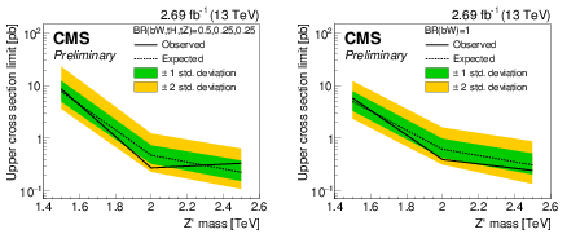
png pdf |
Figure 6:
One-dimensional cross section limits for different Z' masses keeping the T' mass fixed to 1.2 TeV for the BR(bW)= 100% hypothesis (left) and the BR= 50% bW, 25% tH, 25% tZ hypothesis (right). The continuous line is the observed limit, the dotted line is the expected limit, with 1σ (green) and 2σ (yellow) bands. |

png pdf |
Figure 6-a:
One-dimensional cross section limits for different Z' masses keeping the T' mass fixed to 1.2 TeV for the BR(bW) 100% hypothesis. The continuous line is the observed limit, the dotted line is the expected limit, with 1σ (green) and 2σ (yellow) bands. |

png pdf |
Figure 6-b:
One-dimensional cross section limits for different Z' masses keeping the T' mass fixed to 1.2 TeV for the BR = 50% bW, 25% tH, 25% tZ hypothesis. The continuous line is the observed limit, the dotted line is the expected limit, with 1σ (green) and 2σ (yellow) bands. |
| Tables | |

png pdf |
Table 1:
Summary table of the selection criteria for the event categories in the signal region (SR) and the sideband region (SB). |

png pdf |
Table 2:
Number of events in the different event categories of the analysis. The uncertainty quoted includes both statistical and systematic components. |
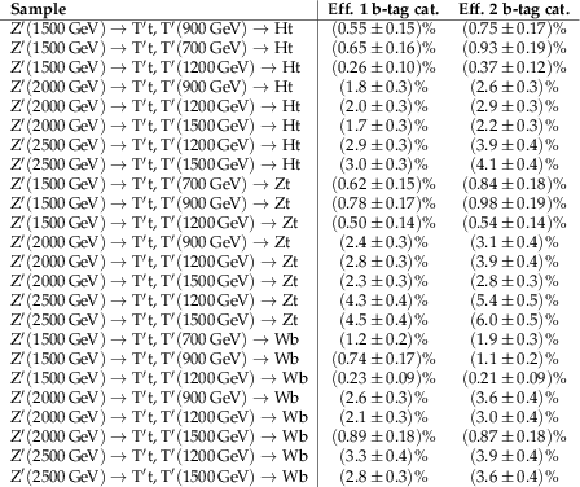
png pdf |
Table 3:
Selection efficiencies for the signal in the different categories used in the analysis. The quoted uncertainties are statistical only. |

png pdf |
Table 4:
Sources of systematic uncertainty considered for the analysis, their rate impact, the systematic type and the processes for which they are relevant. |

png pdf |
Table 5:
Expected and observed 95% CL cross section limits, for the T′→bW signal hypothesis. |

png pdf |
Table 6:
Expected and observed 95% CL cross section limits, for the T′→tH signal hypothesis. |

png pdf |
Table 7:
Expected and observed 95% CL cross section limits, for the T′→tZ signal hypothesis. |
| Summary |
| We have performed the first search for resonances decaying to a top quark and a T' vector-like quark in the all-hadronic channel using √s= 13 TeV data from the LHC Run 2. The focus of the analysis is on the decay of the T' to a W boson and a b quark. The search uses several jet substructure techniques optimized for analysis of 13 TeV data: top-tagging and W-tagging algorithms, along with subjet b-tagging. The top tagging and W tagging algorithms are based on the N-subjettiness variable and the modified mass-drop algorithm to compute the jet mass. We estimate the non-top multijet background using the shape of a sideband region measured in data adjusted with Monte Carlo-based correction factors. The top background is estimated using a Monte Carlo simulation. We set upper limits on the production cross section of Z' bosons decaying to a top quark and a T' vector-like quark. We observe no excess in data with respect to the standard model prediction. Several hypotheses for the masses of the T' quark and the Z' boson are considered, and a scan over possible branching fractions of the T' quark is performed. Depending on the various hypotheses, a Z' boson decaying to a top and a T' is excluded with upper cross section limits ranging from 0.13 pb to 11 pb. |
| References | ||||
| 1 | S. Dimopoulos and H. Georgi | Softly Broken Supersymmetry and SU(5) | Nucl. Phys. B 193 (1981) 150 | |
| 2 | S. Weinberg | Implications of Dynamical Symmetry Breaking | PRD 13 (1976) 974--996 | |
| 3 | L. Susskind | Dynamics of Spontaneous Symmetry Breaking in the Weinberg- Salam Theory | PRD 20 (1979) 2619--2625 | |
| 4 | C. T. Hill and S. J. Parke | Top production: Sensitivity to new physics | PRD 49 (1994) 4454--4462 | hep-ph/9312324 |
| 5 | R. S. Chivukula, B. A. Dobrescu, H. Georgi, and C. T. Hill | Top quark seesaw theory of electroweak symmetry breaking | PRD 59 (1999) 075003 | hep-ph/9809470 |
| 6 | N. Arkani-Hamed, A. G. Cohen, and H. Georgi | Electroweak symmetry breaking from dimensional deconstruction | PLB 513 (2001) 232--240 | hep-ph/0105239 |
| 7 | N. Arkani-Hamed, S. Dimopoulos, and G. R. Dvali | The hierarchy problem and new dimensions at a millimeter | PLB 429 (1998) 263--272 | hep-ph/9803315 |
| 8 | L. Randall and R. Sundrum | A large mass hierarchy from a small extra dimension | PRL 83 (1999) 3370--3373 | hep-ph/9905221 |
| 9 | L. Randall and R. Sundrum | An alternative to compactification | PRL 83 (1999) 4690--4693 | hep-th/9906064 |
| 10 | J. Rosner | Prominent Decay Modes of a Leptophobic Z' | PRB 387 (1996) 113--117 | 9607207v3 |
| 11 | CDF Collaboration | Cross Section for Topcolor Z' decaying to top-antitop | Technical Report FERMILAB-FN-0687, Fermilab | 9911288 |
| 12 | K. Lynch, M. Narain, E. Simmons, and S. Mrenna | Finding Z' bosons coupled preferentially to the third family at CERN LEP and the Fermilab Tevatron | PRD 63 (2001) 035006 | 0007286 |
| 13 | K. Agashe et al. | LHC signals for warped electroweak neutral gauge bosons | PRD 76 (2007) 115015 | 0810.1497 |
| 14 | K. Agashe et al. | LHC signals from warped extra dimensions | PRD 77 (2008) 015003 | 0612015 |
| 15 | CMS Collaboration | Search for anomalous t¯t production in the highly-boosed all-hadronic final state | JHEP 09 (2012) 29 | CMS-EXO-11-006 1204.2488 |
| 16 | CMS Collaboration | Search for resonant t¯t production in lepton+jets events in pp collisions at √s = 7 TeV | JHEP 12 (2012) 15 | CMS-TOP-12-017 1209.4397 |
| 17 | ATLAS Collaboration | Search for resonances decaying into top-quark pairs using fully hadronic decays in pp collisions with ATLAS at √s = 7 TeV | JHEP 01 (2013) 116 | 1211.2202 |
| 18 | ATLAS Collaboration | A search for t¯t resonances in lepton+jets events with highly-boosed top quarks collected in pp collisions with ATLAS at √s = 7 TeV | JHEP 09 (2012) 41 | 1207.2409 |
| 19 | CMS Collaboration | Search for Anomalous Top Quark Pair Production in the Boosted All-Hadronic Final State using pp Collisions at sqrt(s) = 8 TeV | CMS-PAS-B2G-12-005 | CMS-PAS-B2G-12-005 |
| 20 | CMS Collaboration | Searches for new physics using the t¯t invariant mass distribution in pp collisions at √s = 8 TeV | PRL 111 (2013) 211804 | CMS-B2G-13-001 1309.2030 |
| 21 | CMS Collaboration | Search for resonant t¯t production in proton-proton collisions at √s = 8 TeV | PRD 93 (2016) 012001 | CMS-B2G-13-008 1506.03062 |
| 22 | ATLAS Collaboration | A search for t¯t resonances using lepton-plus-jets events in proton-proton collisions at √s = 8 TeV with the ATLAS detector | JHEP 08 (2015) 148 | 1505.07018 |
| 23 | CMS Collaboration | Search for t¯t resonances in boosted semileptonic final states in pp collisions at √s = 13 TeV | Technical Report CMS-PAS-B2G-15-002, CERN, Geneva | |
| 24 | CMS Collaboration | Search for top quark-antiquark resonances in the all-hadronic final state at sqrt(s)=13 TeV | CMS-PAS-B2G-15-003 | CMS-PAS-B2G-15-003 |
| 25 | ATLAS Collaboration | Search for heavy particles decaying to pairs of highly-boosted top quarks using lepton-plus-jets events in proton-proton collisions at √s = 13 TeV with the ATLAS detector | ATLAS Conference Note ATLAS-CONF-2016-014, CERN | |
| 26 | B. A. Dobrescu, K. Kong, and R. Mahbubani | Prospects for top-prime quark discovery at the Tevatron | JHEP 06 (2009) 001 | |
| 27 | D. Greco and D. Liu | Hunting composite vector resonances at the LHC: naturalness facing data | JHEP 12 (2014) 1--50 | |
| 28 | C. Bini, R. Contino, and N. Vignaroli | Heavy-light decay topologies as a new strategy to discover a heavy gluon | JHEP 01 (2012) 1--36 | |
| 29 | N. Vignaroli | New W′ signals at the LHC | PRD 89 (May, 2014) 095027 | |
| 30 | J. A. Aguilar-Saavedra, R. Benbrik, S. Heinemeyer, and M. P\'erez-Victoria | Handbook of vector-like quarks: mixing and single production | PRD 88 (2013) 094010 | 1306.0572 |
| 31 | CMS Collaboration | The CMS experiment at the CERN LHC | JINST 3 (2008) S08004 | CMS-00-001 |
| 32 | CMS Collaboration | Particle-flow event reconstruction in CMS and performance for jets, taus, and EmissT | CDS | |
| 33 | CMS Collaboration | Commissioning of the particle-flow event reconstruction with the first LHC collisions recorded in the CMS detector | CDS | |
| 34 | M. Cacciari, G. P. Salam, and G. Soyez | The anti-kt jet clustering algorithm | JHEP 04 (2008) 063 | 0802.1189 |
| 35 | M. Cacciari and G. P. Salam | Dispelling the N**3 myth for the k(t) jet-finder | PLB 641 (2006) 57--61 | hep-ph/0512210 |
| 36 | M. Cacciari, G. P. Salam, and G. Soyez | FastJet user manual | Eur.Phys.J. C 72 (2012) 1896 | 1111.6097 |
| 37 | M. Cacciari and G. P. Salam | Pileup subtraction using jet areas | PLB 659 (2008) 119--126 | 0707.1378 |
| 38 | CMS Collaboration | Determination of jet energy calibration and transverse momentum resolution in CMS | JINST 6 (2011) P11002 | CMS-JME-10-011 1107.4277 |
| 39 | CMS Collaboration | Identification of b quark jets at the CMS Experiment in the LHC Run 2 | CMS-PAS-BTV-15-001 | CMS-PAS-BTV-15-001 |
| 40 | CMS Collaboration | Top Tagging with New Approaches | ||
| 41 | Y. L. Dokshitzer, G. D. Leder, S. Moretti, and B. R. Webber | Better Jet Clustering Algorithms | JHEP 08 (1997) 001 | hep-ph/9707323 |
| 42 | M. Wobisch and T. Wengler | Hadronization corrections to jet cross sections in deep- inelastic scattering | hep-ph/9907280 | |
| 43 | M. Dasgupta, A. Fregoso, S. Marzani, and G. P. Salam | Towards an understanding of jet substructure | JHEP 09 (2013) 029 | 1307.0007 |
| 44 | A. J. Larkoski, S. Marzani, G. Soyez, and J. Thaler | Soft Drop | JHEP 05 (2014) 146 | 1402.2657 |
| 45 | CMS Collaboration | Identification of b-quark jets with the CMS experiment | JINST 8 (2013) P04013 | CMS-BTV-12-001 1211.4462 |
| 46 | CMS Collaboration | Search for resonant tˉt production in proton-proton collisions at √s= 8 TeV | PRD 93 (2016), no. 1, 012001 | CMS-B2G-13-008 1506.03062 |
| 47 | J. Thaler and K. Van Tilburg | Identifying Boosted Objects with N-subjettiness | JHEP 1103 (2011) 015 | 1011.2268 |
| 48 | J. Thaler and K. Van Tilburg | Maximizing Boosted Top Identification by Minimizing N-subjettiness | JHEP 1202 (2012) 093 | 1108.2701 |
| 49 | J. Alwall et al. | The automated computation of tree-level and next-to-leading order differential cross sections, and their matching to parton shower simulations | JHEP 07 (2014) 079 | 1405.0301 |
| 50 | CMS Collaboration | Search for a vectorlike top partner produced through electroweak interaction and decaying to a top quark and a Higgs boson using boosted topologies in the all-hadronic final state | CMS-PAS-B2G-16-005 | CMS-PAS-B2G-16-005 |
| 51 | P. Artoisenet, R. Frederix, O. Mattelaer, and R. Rietkerk | Automatic spin-entangled decays of heavy resonances in Monte Carlo simulations | JHEP 03 (2013) 1--19 | |
| 52 | T. Sjostrand et al. | An Introduction to PYTHIA 8.2 | CPC 191 (2015) 159--177 | 1410.3012 |
| 53 | M. L. Mangano, M. Moretti, F. Piccinini, and M. Treccani | Matching Matrix Elements and Shower Evolution for Top-Quark Production in Hadronic Collisions | JHEP 01 (2007) 013 | |
| 54 | P. Nason | A New method for combining NLO QCD with shower Monte Carlo algorithms | JHEP 11 (2004) 040 | hep-ph/0409146 |
| 55 | S. Frixione, P. Nason, and C. Oleari | Matching NLO QCD computations with Parton Shower simulations: the POWHEG method | JHEP 11 (2007) 070 | 0709.2092 |
| 56 | S. Alioli, P. Nason, C. Oleari, and E. Re | A general framework for implementing NLO calculations in shower Monte Carlo programs: the POWHEG BOX | JHEP 06 (2010) 043 | 1002.2581 |
| 57 | S. Frixione, P. Nason, and G. Ridolfi | A Positive-weight next-to-leading-order Monte Carlo for heavy flavour hadroproduction | JHEP 09 (2007) 126 | 0707.3088 |
| 58 | E. Re | Single-top Wt-channel production matched with parton showers using the POWHEG method | EPJC 71 (2011) 1547 | 1009.2450 |
| 59 | M. Czakon and A. Mitov | Top++: A Program for the Calculation of the Top-Pair Cross-Section at Hadron Colliders | CPC 185 (2014) 2930 | 1112.5675 |
| 60 | N. Kidonakis | Top Quark Production | in Proceedings, Helmholtz International Summer School on Physics of Heavy Quarks and Hadrons (HQ 2013) | 1311.0283 |
| 61 | M. Aliev et al. | HATHOR: HAdronic Top and Heavy quarks crOss section calculatoR | CPC 182 (2011) 1034--1046 | 1007.1327 |
| 62 | P. Kant et al. | HatHor for single top-quark production: Updated predictions and uncertainty estimates for single top-quark production in hadronic collisions | CPC 191 (2015) 74--89 | 1406.4403 |
| 63 | NNPDF Collaboration | Parton distributions for the LHC Run II | JHEP 04 (2015) 040 | 1410.8849 |
| 64 | CMS Collaboration | Event generator tunes obtained from underlying event and multiparton scattering measurements | EPJC 76 (2016), no. 3, 155 | CMS-GEN-14-001 1512.00815 |
| 65 | CMS Collaboration | Boosted Top Jet Tagging at CMS | CMS-PAS-JME-13-007 | CMS-PAS-JME-13-007 |
| 66 | T. Muller, J. Ott, and J. Wagner-Kuhr | Theta \-− a framework for template-based modeling and inference | ||
| 67 | G. Cowan | PDG Review on statistics (chap. 33) | JPG 83 (2010) 075021 | |

|
Compact Muon Solenoid LHC, CERN |

|

|

|

|

|

|